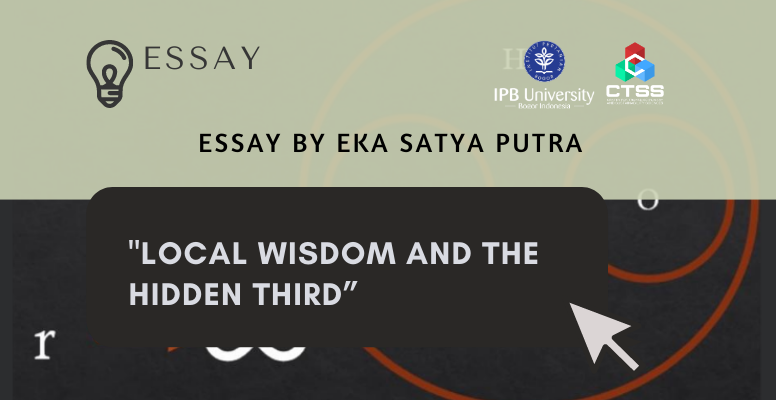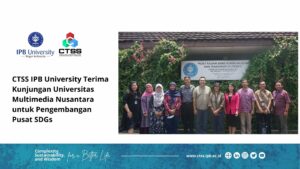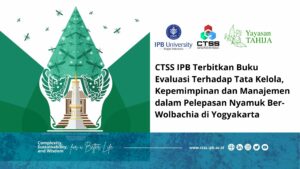Deconstructing and Reconstructing Local Wisdom for Sustainability by Eka Satya Putra
Abstract
Sustainability has become a key word in our increasingly interconnected and interdependent world. It has becoming a key word in many systems that construct our life but mainly it rings very loud in the aspect of human relation with nature or human interaction with the ecosystem. Humans are slowly realizing it needs to take a collective action to preserve nature for our future generations or perhaps for humanity itself to survive. Local wisdom which is balancing the needs of humans and the capacity of nature to fulfill those needs, is seen as to be a potentially significant contributing factor to compound sustainability efforts and results. Unfortunately, there no methods or methodology to do as such, this paper is forwarded to stimulate our thoughts and desire to formulate those methods or methodology.
Keywords: system, complexity, interdependence, emergent properties, hidden third, local wisdom
System: complex, complexity and interdependence
System is an interconnected set of elements that is coherently organized in a way that achieves something (Meadows, 2008). Systems is our daily fact of life although maybe we are not aware most of the time because in our current interconnected world, systems are built upon layer of other systems. For example, when you are charging your handphone to an AC outlet it seems a very easy task and does not require a system or even a complex system to achieve the purpose. Try to imagine where does electricity comes from? It comes from a vast and complicated electric network distributing the electricity from the source to your house or home or which ever place you are charging your handphone. The electric network must increase the electricity voltage from the source so the electricity can be distributed with the least possible time and as wide area as possible then it must reduce the voltage when the electricity arrived at the point of usage as per your equipment requirement. Imagine also the system required to build the electric powerhouse, the system for generating electricity, the system to feed the energy to keep generating electricity and so forth. When you plug your handphone AC what you can see is the result which is nearest to your proximity and not the whole complex of systems generating and distributing electricity. With systems being built upon layer of other systems the natural consequences are the evolvement of a complex system. Complex system becomes ubiquitous in every aspects of our life generating complexity. But what is a complex system? And hence what is complexity? A group of researchers stated “it is commonly implied that there is such a thing as a complex system across the disciplines. However, there is no concise definition of a complex system, let alone a definition that all disciplines agree on” (Ladyman, Lambert, & Wiesner, 2013).
A possible approach with the potential to resolve this dilemma is a view by a physicist who mention:
“What can we say about the complexity of society? To start thinking about this problem, we might notice that the world has become much more interdependent. This is what we mean when we refer to the “global economy”. The interdependence means that something happening in one place in the world can, and often does, affect things happening in another place, even in many different places around the world. If things are more interdependent, the complexity of the world at larger scales has increased” – BAR-YAM, COMPLEXITY AND SCALE (in Organization, 2004)
The keyword to complexity is interdependence.
Sustainability: An emergent property from complexity
A physicist stated “emergence refers to the relationship between the details of the system and the larger view “ (Bar-Yam, Parts, Wholes and Relationship, 2004). The larger view mentioned means the larger view of the system, emergence is referring to the relationship between element of the system and the system like the relations between the trees and the forest that shapes the forest and the forest behavior which none of the trees have.A researcher stated, “An emergent property is a property which a collection or complex system has, but which the individual members do not have. A failure to realize that a property is emergent, or supervenient, leads to the fallacy of division” (Sinjab, 2012). This researcher describes an example of emergent properties:
“In biology, for example, heart is made of heart cells, heart cells on their own don’t have the property of pumping blood. You will need the whole heart to be able to pump blood. Thus, the pumping property of the heart is an emergent or a supervenient property of the heart. Claiming that an individual heart cell can pump blood because the heart can would be an example of fallacy of division.” – SINJAB (2012)
Stated in another way, the statement of emergence and emergent properties: emergence have something to do with the relationship between the element of the system and the system itself producing the emergent properties, producing a property that the system has but the elements of the system does not have. Emergent properties seem to come from nested system, a collection of systems (sub-systems) constructing a complex system creating a complexity from interdependence among those sub-systems and interconnectedness of elements in the sub-systems.
Would you say that a human is an emerging phenomenon and having emergent properties? Maybe mostly will say no but consider this, the human body is a system consisting of sub-system such as the integumentary system, muscular system, skeletal system, nervous system, and others. None of those system independently can create the properties that a human can do and those system works very efficiently and seamlessly so most of the times we take it for granted. And those complex system and their inherent complexity, called human, built a system upon their system among others which we call social system. Again, can we attribute to a social system as a complex system with emergent properties? On a scale of a single system we may say it is complicated but not complex but on a scale of many social systems with interconnections and interdependency we may say it is a complexity and exhibits emergence phenomenon and emergent properties. Hence, again, it seems that emergent properties, regardless of scale, is originating from a nested system depended on interdependency and interconnectedness of those sub-systems and element within it.
Transdisciplinary: The Hidden Third
People from all walks of life (Multiple Realities) enter this fecund “middle ground” (zone of non-resistance, ripe with potential and possibilities) prepared to remain open to other’s viewpoint so they can use inclusive logic, temporarily reconcile contradictions, while respecting emergence, synergy and fusion, and integrate ideas and form new complex, embodied, and cross fertilized knowledge that can be used to address the complex problem (McGregor, 2015).
Above is McGregor describing The Hidden Third in Nicolescuian Approach of Transdisciplinary. You probably notice there are some keywords in the description such as emergence, complex and complex problem. It describes an area which may produce emergence phenomenon and emergent properties through “a non-resistance state and integrate ideas and form complex, embodied and cross fertilized knowledge that can be used to address the complex problem” (McGregor, 2015). This concept of The Hidden Third will be used to deconstruct and reconstruct local wisdom to compound the sustainability efforts and results.
Local Wisdom: Becoming an emergent property to be integrated into Sustainability
By the term of local wisdom, I define it as a set of principle or law indigenous to a local social system that governs that social system interaction with nature and element within it with the intent of preserving the balance between the social system and nature or in other word creating and preserving sustainability between nature and social system.
With the world becoming more interconnected and social system becoming more focused on economic growth, it seems local wisdom are becoming more irrelevant and is slowly abandoned and the local knowledge within it that is a major cornerstone to build a local sustainability is lost. Local wisdom became a myth rather than an important tool or means between social system and nature.
Sustainability being a key word of an international agenda in the form of SDG revives some interest in local knowledge as a sustainability strategy. But with the lost of some knowledge, or even some local wisdom, the fact that the world is more interconnected which means enlargement of the social system and the shift of interest to a more economic oriented, local wisdom per se is very difficult to be integrated to a sustainable strategy or even worse seems not to be the once omnipotent factor. What is requirement is a deconstructing and reconstructing of local wisdom to have an emergent property to enable it to become a contributing factor in sustainability.
How to deconstruct and reconstruct local wisdom to become an emergent property? With the explanation above I think the answer is obvious, as a principle answer increase the complexity of the local wisdom which means making the local wisdom into a nested system and increase the interconnectedness and interdependency of the sub-system. The not so obvious is how you should proceed to do it with the multi stakeholder inside the systems? This is where The Hidden Third comes to play, it is required to find The Hidden Third among the multi stakeholder. It is hoped with the existence of local wisdom or there was once a local wisdom would make the journey in finding The Hidden Third to be more optimistically achieved though it is no guarantee to be easier. In other word use process of the local wisdom deconstruction and reconstruction itself to put the balance back into social system interaction with nature.
References
Bar-Yam, Y. (2004). Complexity and Scale in Organization. In Y. Bar-Yam, Making Things Work (pp. 61-62). United States of America: NECSI Knowledge Press.
Bar-Yam, Y. (2004). Parts, Wholes and Relationship. In Y. Bar-Yam, Making Things Work (p. 27). United States of America: NECSI Knowledge Press.
Ladyman, J., Lambert, J., & Wiesner, K. (2013, June). What is a complex system? Retrieved from ResearchGate: https://www.researchgate.net/publication/50210075_What_is_a_complex_system
McGregor, S. L. (2015, June 11). The Nicolescuian and Zurich Approaches to Transdisciplinarity. Retrieved from Integral Leadership Review: http://integralleadershipreview.com/13135-616-the-nicolescuian-and-zurich-approaches-to-transdisciplinarity/
Meadows, D. H. (2008). The Basics. In D. H. Meadows, Thinking in Systems (p. 11). White River Junction: Chelsea Green Publishing.
Sinjab, I. (2012, December 12). What is your definition of emergent properties? Retrieved from ResearchGate: https://www.researchgate.net/post/What_is_your_definition_of_emergent_properties





